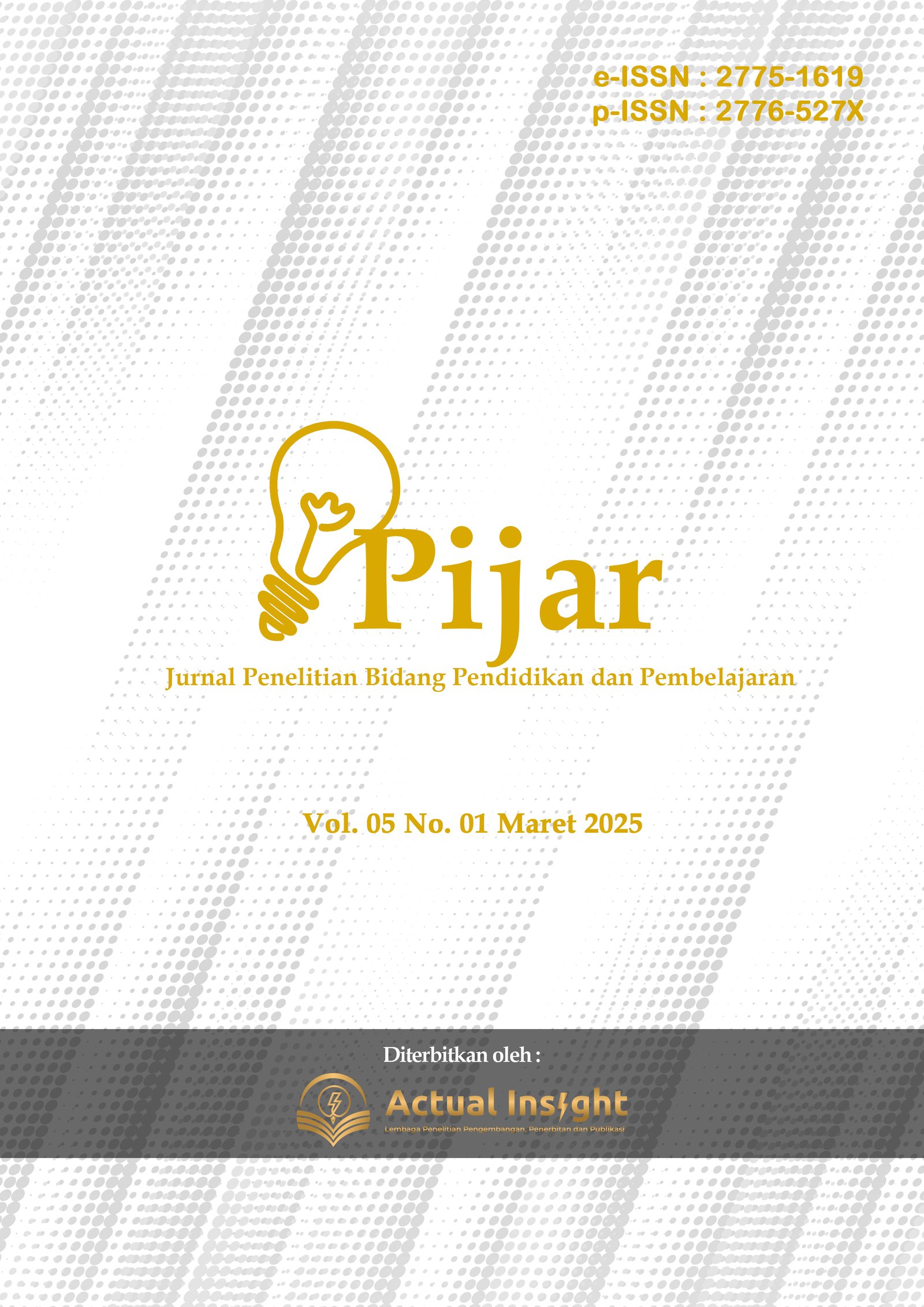Application of Problem-Based Learning Model and Role Play Assisted by Moneybag Media to Improve Financial Literacy of Elementary School Students
DOI:
https://doi.org/10.56393/pijar.v5i1.3281Keywords:
Role Play, Moneybag, Literasi FinansialAbstract
Financial literacy is a crucial life skill encompassing knowledge, attitudes, and behaviors related to managing finances wisely. However, the financial literacy level of second-grade students in Class 2A at State Elementary School Kebonsari 3 Malang City remains low. This study aims to enhance students’ financial literacy through the implementation of a Problem-Based Learning model integrated with the Role Play method, supported by the use of Moneybag media in the topic "Wise Use of Money." The research employs a Classroom Action Research (CAR) approach conducted over three cycles. Data were collected through observation, questionnaires, and documentation, and analyzed using descriptive quantitative methods. The findings indicate a progressive improvement in students’ financial literacy scores, increasing from an average of 63.14 in the first cycle to 66.57 in the second cycle. The integration of Moneybag media in the second cycle yielded a completion rate of 75%, surpassing the predetermined success criterion of 70%. Further enhancements in the third cycle, achieved through the incorporation of the Role Play method, resulted in a significant increase in the completion rate to 89.38%, categorized as very good. These results provide practical insights for elementary school educators in designing interactive and contextual financial literacy instruction. Theoretically, the study reinforces the effectiveness of combining Problem-Based Learning and Role Play in fostering foundational financial competencies among young learners.
Downloads
References
Achmad, Z. A., Arista, Z. F., Ratnawati, R. A., Isnan, M., & Prastyo, A. S. (2024). Basic financial literacy for Jerili Christian Elementary School students to improve economic knowledge. Amaliah: Journal of Community Service, 8(2), 300-309.
Afidah, S., Wardhani, I. S. K., William, N., Pratiwi, D. J., & Puspasari, Y. (2023). The influence of role-playing methods to improve financial literacy in grade V students of SDN 1 Tawing. RESPONSE: Journal of Basic Education Research and Innovation, 3(2), 86–93. https://doi.org/10.55933/tjripd.v3i2.593
Anugrah, R. (2018). The effect of financial literacy and financial attitudes on people's financial management behavior with intention as an intervening variable. Thesis, Makassar: UIN Alauddin.
Arianti, B. F. (2022). Financial literacy (theory and implementation).
Ayu, F. (2024). Analysis of Market Day Activities to Improve Understanding of Currency Value in Early Childhood. Multidisciplinary Scientific Journal, 1(5), 87-90. Accessed on: https://journal.smartpublisher.id/index.php/jimi/article/view/443.
Damanik, D., Erfiyana, N., Simanjuntak, R., Simanjuntak, M., Tarigan, H. E., Evi, P. A. M., & Marbun, R. (2023). Socialization of financial literacy and Rupiah CBP for elementary school students in Simalungun Regency. Journal of Community Service Sapangambei Manoktok Hitei, 3(1), 49–54. https://doi.org/10.33369/tribute.v5i2.36716
Gultom, B. T., HS, S. R., & Siagian, L. (2022). The impact of financial literacy on student financial behavior: A case study at HKBP Nommensen University Pematang Siantar. Journal of Economics Education Undiksha, 14(1), 135–145. https://doi.org/10.23887/jjpe.v14i1.46896
Hikmah, R. N. (2023). Socialization of Numeracy Literacy in Market Day Activities. Journal of PkM (Community Service), 6(5), 591-598.
Hikmah, Y. (2020). Financial literacy in elementary school students in the city of Depok, West Java province, Indonesia. Journal of Community Service, 26(2), 103.
Indrayani, L. (2020). The meaning of financial literacy in the sustainability of the Balinese women's household industry. JIA (Scientific Journal of Accounting), 5(2), 407-428.
Intaniasari, Y., Utami, R. D., Purnomo, E., & Aswadi, A. (2022). Fostering enthusiasm for learning through audio-visual media in elementary school students. Learning Tool Development Bulletin, 4(1).
Jufri, A. P., Asri, W. K., Mannahali, M., & Vidya, A. (2023). Learning Strategies: Exploring Learning Potential Through Effective Models, Approaches, and Methods. Ananta Vidya.
Kartini, A., Asmaniah, Z., Julianti, E., & Key, K. (2022). Financial literacy education: impact and benefits (a literature review). Code: Journal of Language, 11(3).
Kemmis, S., McTaggart, R., & Nixon, R. (2014). The Action Research Planner. In The Action Research Planner. https://doi.org/10.1007/978-981-4560-67-2
Kristin, F. (2018). Meta-analysis of the influence of role playing learning models on social studies learning outcomes. Educational Reflections: Scientific Journal of Education, 8(2).
Laila, V., Hadi, S., & Subanji, S. (2019). Implementation of financial literacy education for elementary school students. Journal of Education: Theory, Research, and Development, 4(11), 1491-1495.
Machali, Imam. (2022). How to conduct classroom action research for teachers. Ijar, 1(2): 2022-12.
Marfu'ah, S., Aguspriyani, Y., Saraswati, H., Ibrahim, Z., Hillalliyati, N., Aini, A., & Raya, F. (2025). Increasing Awareness and Maximizing Coin Transactions in Early Childhood at Tunas Insan Kamil Kindergarten, Serang City. AKM: Action to the Community, 5(2), 619-628.
Mubarok, F. (2019). An Experimental Approach To Learning. Iftitah: Scientific Journal of Early Childhood Islamic Education, 1(2), 27-34.
Mukmin, M., Gunawan, A., Arif, M., & Jufrizen, J. (2021). Testing of Students' Financial Literacy. Scientific Journal of Management and Business, 22(2), 291-303.
Muktamar, A., Iswahyudi, M. S., Salong, A., Wote, A. Y. V., Rahmatiyah, R., Riyadi, S., ... & Leuwol, F. S. (2023). Education Management: Concepts, Challenges, and Strategies in the Digital Era. PT. Sonpedia Publishing Indonesia.
Ni'mah, Z. A. (2017). The urgency of classroom action research for the improvement of teachers' professionalism between mind and fact. Reality: Journal of Islamic Research and Culture, 15(2).
Nusron, L. A., Krismiatun, E. W., & Diansari, R. E. (2021). The Influence of Learning in Higher Education and Financial Education in the Family on Financial Literacy. Akmenika: Journal of Accounting and Management, 18(1).
Pandiangan, A. P. B. (2020). Classroom action research (as an effort to improve the quality of learning, teacher professionalism and student learning competence). Deepublish.
Prodyanatasari, A., Marsida, R., Maharani, A., Kharisma, D. W., & Primanda, L. T. (2025). Learning While Playing: Improving The Financial Literacy Of Elementary School Students Through Social Drama Of Buying And Selling. Indonesian Journal of Multidisciplinary Service (JUPEMI), 2(3), 26-36.
Rapih, S. (2022). Financial Literacy Education for Children: Why and How?. Scholaria, 6(2): 14-28.
Wacanno, O. A. (2022). Multimedia Learning uses Adobe Flash as an educational game in the introduction of the rupiah currency in elementary school first grade students. Indonesian Journal of Networking and Security (IJNS), 11(3).



